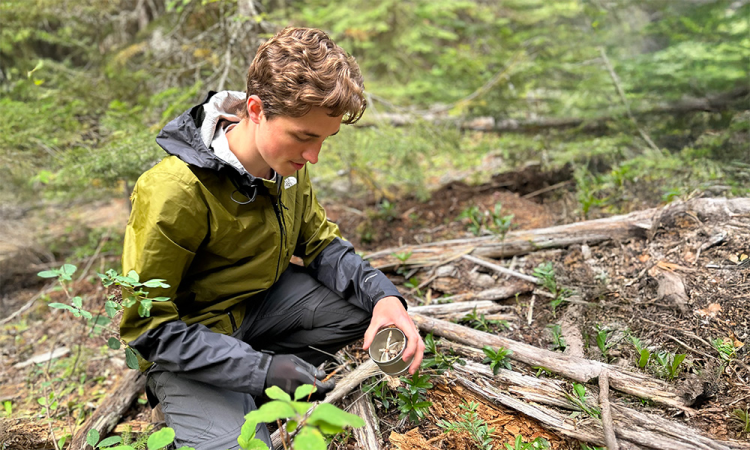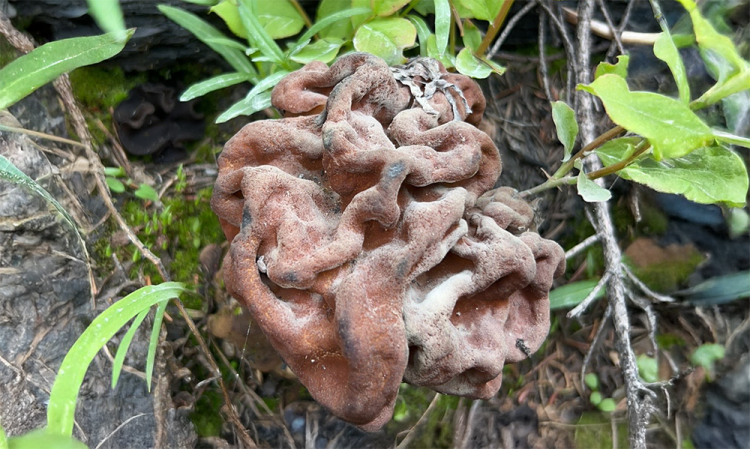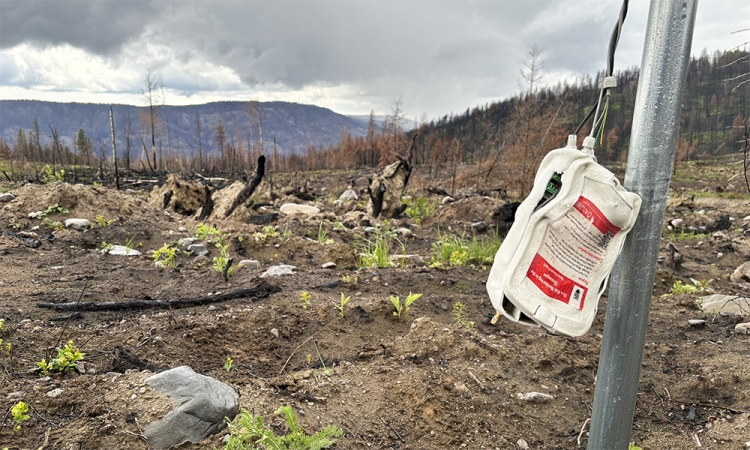By mid-July, they could predict the day by the heat. Some mornings started at 6 a.m. to beat the 40C weather. Most days involved long drives, station repairs or scrambling through dry forest understories with armfuls of sampling gear.
But what started as fieldwork for UBC Okanagan students Ainsley Lirondelle, Jed Prentice and Olivier Parrott-Landry soon became something more profound a crash course in fire science, place-based knowledge and unexpected friendship.
They jokingly called themselves the "Three Amigos," a nickname born from long hours together and a friendship built on sweat, science and fieldwork.
"We started joking about it partway through the summer," says Prentice. "We were together every day, driving around and working long hours. It just made sense we were a package deal."
Parrott-Landry added, "You really get to know each other. You're in the truck, in the bush, eating lunch by a creek. You don't see anyone else for weeks at a time. It makes you close, fast."
Finding purpose in data and monitoring
The trio worked under the guidance of UBC Okanagan wildfire scientist Dr. Mathieu Bourbonnais. Lirondelle was funded by an NSERC-Undergraduate Student Research Award for Indigenous students, and Prentice and Parrott-Landry were hired as summer research assistants both funded summer research opportunities that connect students with hands-on experience in active projects.
The group reflected the interdisciplinary nature of wildfire research, bridging sustainability science, computer modelling and ecological fieldwork to build a fuller picture of a changing landscape.
Though each student brought a different background, they worked together daily, maintaining monitoring stations, collecting samples and supporting long-term monitoring efforts across the region.
Lirondelle, an Earth and Environmental Sciences major, spent consecutive summers in the program. Her work focused on the long-term establishment and maintenance of weather stations and monitoring plots, essential infrastructure for understanding how fire moves across landscapes.
"I didn't know much about fire coming into the summer," says Prentice, now a fourth-year student in the Bachelor of Sustainability program. "But going into the forest and doing something practical .It's a great way to learn, and it made me feel like I'm contributing to something."
Parrott-Landry had just completed his first year intending to major in Computer Science when he joined the project. He connected with Dr. Bourbonnais and landed a fieldwork role that grounded him in a new direction.
"We were out there every day collecting data that gets used in real-time," says Parrott-Landry. "That feels good. It's not just for a class or a grade it matters."

Jed Prentice holds a sample jar used to collect data for long-term wildfire research in the Okanagan.
Rethinking forest management and wildfire risk in the Okanagan
The research opened their eyes to a central truth about the Okanagan: what appears to be wilderness is often anything but.
"Everything looks natural until you realize how manipulated it is," says Prentice. "The Okanagan wasn't supposed to look like this. It's been replanted and fire-suppressed for decades."
They learned how fire exclusion policies have led to tightly-packed stands of similar-age trees that burn hotter and faster than historic landscapes ever did.
"I've had so many conversations where I explain that fire is a forest management issue, not just a weather problem," says Lirondelle. "People are always surprised. They think fire is this external force. It's not. It's the result of how we've managed the land."

A large polypore mushroom, likely a red-belted conk (Fomitopsis mounceae), one of the many fungi noted by students during their fieldwork.
Building local knowledge through hands-on sustainability research
Lirondelle, who moved to BC from central Alberta, says the project changed her relationship with the land itself.
"Before, I'd just walk through a forest. Now I can name the plants. I know what they are, what they do and why they're here," she says. "That knowledge makes you feel connected to a place."
For Parrott-Landry, that growing familiarity made every day feel more personal. "You get attached to certain spots. Like, That's the one with the big patch of this plant,' or that's where we always find the best samples.' It's a weird kind of friendship."

A damaged wildfire monitoring sensor shows the intensity of past fires and the importance of maintaining long-term equipment in the field.
Indigenous land stewardship and cultural fire practices
Among the most lasting lessons wasn't one they uncovered, but one they acknowledged.
"The syilx Okanagan people have long used cultural burning to care for this land," says Lirondelle. "It's already known we're just catching up."
Dr. Bourbonnais, they noted, made space for these conversations in both the field and the lab. "He's intentional about recognizing whose land we're on," says Parrott-Landry. "It's not just a land acknowledgement at the start of class. It's part of how we work."
An array of collected field samples demonstrates the range of data UBC Okanagan students gathered over the summer.
Future careers in wildfire research and environmental science
None of the three began their studies knowing exactly where it would lead. But the long days, road miles and forest plots gave them more than data. It gave them clarity.
"I'm starting a Master's degree," says Lirondelle. "Bringing good fire back to the land, that's what I want to be part of."
For Parrott-Landry, the summer nudged him to declaring a second major in Earth and Environmental Sciences. "I thought I was just a Computer Science student. But now I want to do more of this."
For Prentice, it confirmed what he already knew: "I love the Okanagan. And I want to do something that is needed here. That's what this showed me."













